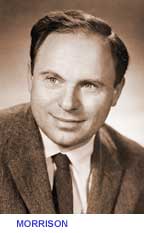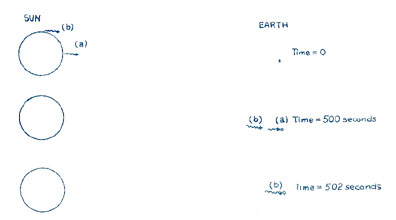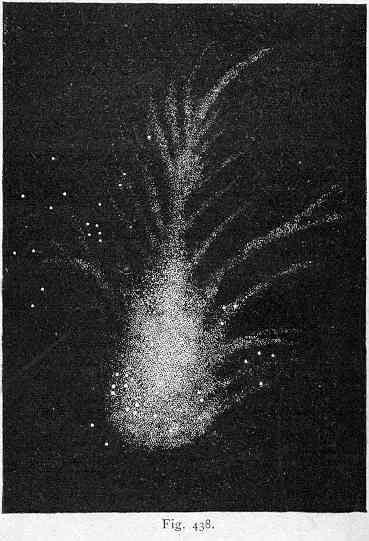A Pulsar Discovery
Imagine
the situation in the astronomy community in 1968. A graduate student doing
some ordinary measurements of  radio
stars has come across a phenomenon that is truly extraordinary. A star is
blinking on and off ten times per second. How could this be? How could a
star turn its radio emissions on and off so rapidly? In any star there exists
a fire of incredible temperature—hotter than the largest furnace on
earth. How could it turn on, then off, over and over again?
radio
stars has come across a phenomenon that is truly extraordinary. A star is
blinking on and off ten times per second. How could this be? How could a
star turn its radio emissions on and off so rapidly? In any star there exists
a fire of incredible temperature—hotter than the largest furnace on
earth. How could it turn on, then off, over and over again?
Astronomers all over the world begin to look for other "pulsars," and sure enough, such objects are everywhere in the skies. In the year following the initial discovery, 27 pulsars are discovered. All, however, can only be detected by their radio waves. These radio sources emit relatively small amounts of energy.
A race begins. Would anyone locate a pulsar which emitted so much energy that it could be observed with ordinary light? If an optical pulsar could be found, it would be a major help in solving the "pulsar problem." Some of the most famous astronomers enter the race, equipped with the world's largest telescopes. The winners, however, are two unknown young scientists who had only recently met. What's more, they had never before operated a telescope. This is their story.
Don't try to learn about pulsars from this exhibit. Try to learn about science itself, and the people who practice science. Pay attention to the procedures, not the particular facts. Listen carefully and you will hear more than the excitement of a moment of discovery. You will hear people who want the discovery to be real, but who do not hide from the possibility that it is all a mistake.
In this exhibit, John Cocke and Michael Disney describe the events leading up to their discovery. Philip Morrison, Professor of Physics at the Massachusetts Institute of Technology, gives background information and his own personal recollections. But that is not all. Incredible as it may seem, a tape recorder installed to keep track of the data also recorded all the conversation on the night of the discovery. The scientists only wanted to note the steps in their observations, but in fact the microphone heard everything they said. As you listen to excerpts of that audio, you will witness an actual discovery. You will share the excitement of this historic evening.
We begin with Philip Morrison...
MORRISON: In '68 January or February of that year—I remember myself meeting at the airport a friend who just returned from Great Britain, an astronomer. And he said, "Have you heard the latest?" And I said, "Well, what's that?" He said, "They've got something that pulses every second—a stellar signal that pulses every second." I said, "Oh, that couldn't be true!" "Yes," he said, "it's absolutely true. They announced it recently. They've studied it for about five or six months. It's extraordinary."
That was the announcement of the discovery of what we now call a pulsar, which was announced by the group at Cambridge University in England—the first to discover it—very early in the winter of 1968 as I recall, about January or February. Indeed, the graduate student, Jocelyn Bell, had first picked up the first pulsar several months before. But in Cambridge, they sat on these results for several months, because the whole thing was so extraordinary and so unexpected, that they didn't want to release it until they had a chance to confirm it.
The reason of course is quite simple. We think of the stars quite sensibly as being— well we say the fixed stars—as being eternal, long-lived, everlasting. And even though we know that's not 100% true—that the star sometimes explodes a little bit, making a nova, or explodes disruptively flinging itself apart entirely, making a supernova—still those are not really fast events from a human time scale. If they take a few seconds or a day, that would be remarkable for a star. You don't see much happening on the stars in a second.

And yet these people heard unmistakably from some middle distant stars, radio signals that went tick, tick, tick, tick, like that—very sharp ticks—lasting a fraction of a second, repeated every half second or second or so. It's interesting to hear the audio recording—the tape recording—of the radio astronomer's clicks when he records such a pulsar. So we knew something remarkable was going on and people gave it a name, pulsar.
By late summer of that same year—of course the whole astronomical community was galvanized in looking at it—and everybody with a radio telescope began looking in radio waves for pulsars, here, there and everywhere because it was clear they were there for the finding. And the number discovered grew by leaps and bounds. I don't remember how many, but certainly there were dozens by the end of the year.
This is a story from the vintage year of 1968.
 |
| Drawing of the Crab Nebula by William Parsons, the Third Earl of Rosse, made about 1844. |
Sound of a pulsar. [ Volume Warning ]
(From "The Sounds of Pulsars")